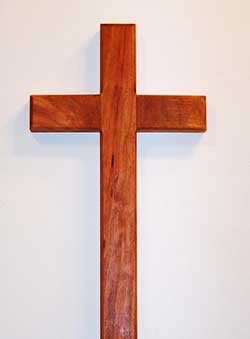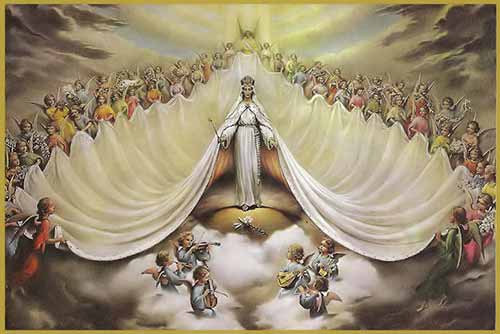I recently shared an image of the Crowning which resulted in some fascinating discussion. Some object to nudity. Others suggested it is blasphemous.
A good question arose: Where is the line? Where does “challenging” become “objectionable”? And “blasphemous”?

I have worshiped in Sydney Anglican churches which regard an empty cross as idolatry. Their line lies in quite a different place to the majority Christian position.
I laugh as much as the next person when people joke about Christianity, even take the piss out of Christianity (am I allowed to use the word “piss” here – or have I just crossed your line? Remember St Paul used the word “shit” in the inspired Word of God – did Paul cross your line? Did God?). Recently I was watching a TV programme which took the piss out of Christianity. It was filmed in a building consecrated to the worship of God. It certainly brought up the question for me: was my line crossed?
Where is your line when icon becomes idol, when image becomes blasphemy? And why?
I know I have an internal reaction when, in a jewellery shop, I overheard someone wanting to purchase a cross, “but do you have one with a little man on it?”…
*****
During this Southern-Hemisphere, Aotearoa-New Zealand, go-slow season sometimes your comments may take longer than usual to get through moderation…
If you have not done so already, I encourage you to “like” the liturgy facebook page.




I couldn’t help giggling at the sight of the little cherubs playing their stringed instruments in the image above. My 11-year-old son and I couldn’t figure out who the central figure is – male or female? It crosses my line – but only into the humorous. An ‘auntie’ of mine has on her sideboard a large-ish statuette of Jesus of the Sacred Heart. She is ‘looking after it’ (for the last 50 years or so) because the local convent was going to throw it out after Vatican II, and one nun, who had formed a strong attachment to the statue, was caught running away with it under her habit. I must admit when I was younger I thought the statue beautiful, then as a puritanical Baptist youth and thought it idolatrous, now as a middle-aged Anglican I think it is beautiful again, and a constant reminder of the mercy and inclusiveness of Jesus.
For this particular post, Gillian, I was looking through images of Jesus crowning Mary. Fascinating possibilities came up – but I was particularly looking for one that was a bit “edgy”. This one caught my attention to sharpen my questions. Blessings.
I’m grateful this “edgy” didn’t require brain bleach like the last time you wanted to use edgy!
The picture shown resembles another called “Aphrodite born from the Ocean” or something like that. The picture is another example of the worship of Mary. I cannot understand how anyone could use it as a means of meditating onGod, Jesus or the Trinity. It doesn’t even depict Mary’s humanity.
I don’t see the painting as depicting worship in any way. This, to me, depicts honor as to her position as Theotokos.
I think it’s idolatry when you stop at the object, and worship the object itself rather than what it represents. I think Roman Catholics are often accused of idolatry, but to me personally, the images and statues are a way into the faith. They are a reminder, and an object to aid meditation.
As for blasphemy, I would say when it is done in a spirit of desecration or extreme scorn rather than a respectful — even if vividly or confrontationally presented — interpretation or commentary, then I would say they could be blasphemous. IMO, it all depends on the spirit with which these images (or words) are presented. Jesus Christ was accused of blaspheming, so that’s a word I would be very hesitant to use. It’s pretty hard to police the “blasphemers'” intent.
Very helpful points, thanks, Davanna. Blessings.
Ok, so for once i do not like your questions Bosco! [snort] Yes, you are ofcourse right; one persons taste is not another; and yes, is dung the right word or are we dressing up an actual equivilant of the word used by Paul, and yes, how do we accurately understand/translate common greek or was it a mixture of common greek and nicer greek.
So yup, my dislike is based around that one word but also the p word.
Somehow i cannot see Jesus using the equivliant swear words of 1st century BCE. I would love to see some references as a quick google doesn’t help me much 🙂
Ofcourse, its a naughty red herring Bosco, as we are meant to live our lives to bring others to Christ, to point to him, to talk about him, to glorify him by the way we interact with others.
But this ofcourse still leaves you being naughty by asking where our lines are, i.e. which ones do I notice/ignore/react to/dislike or worse cross myself?
And as for the wee man on the cross…..ARHHH!! how secular we in NZ are 🙁 or just simply grossly ignorant 🙁
Snort: bad boy, good post!
“Bad boy, good post!” – love it, Paddy. Blessings.
“Preach the gospel always. When necessary use words”‘/
Words are blasphemous in complete context in which they are used, not in te word as word. When Chaucer used word “quente” it was descriptive not blasphemous. But when that alleged church in Westboro uses word “slag’ at American military funerals that is blasphemous.
Woah – the diaphanous immaculate labia I did not need to see. Over my line and well into liturgical po-n, for theological and imaginative reasons. Enough, please. [Scratching eyes]
Your pixel resolution on your computer screen must be far in advance of mine, Paul! And here was I thinking that liturgical po-n is things images of the humeral veil. Blessings.
There is no need for high resolution pixelation – the (?male) mind alone is sufficient to see patterns where it will, particularly those with potency at a deep conceptual or visceral level. In the case above, both apply. I suspect the mysteries of Creation and Incarnation have been deliberately placed in a subliminally-erotic context. For some, perhaps this is empowering, but for this neat-minded male it’s distracting. The category conflation presents too strong a shift in imaginative/devotional focus from the Creator to the created order.
A lot of Christian objects and/or persons can become mere hindrances to our access to God. (Although they don’t necessary need to be idols.) And thus they become blasphemies, not so much towards the Creator as towards the creature.
When I was a kid, and my grandma brought me to church, the iconostasis was the very object that made me reject Christianity. With the iconostasis hindering the view to the altar, and all the prayers being said silently by the priest while the congregation was singing, the Liturgy seemed nothing more than a montage of dull songs with a sermon.
«If meat causeth my brother to stumble, I will eat no flesh for evermore, that I cause not my brother to stumble»
If an icon or statue or any art brings false theology, throw it away. Iconoclasm is not about throwing garbage. On the contrary, people who refuse our senses at worship have usually (if not always) a problem with chistology and incarnation.
I don’t seem to have a consistent view. Sometimes I think images more detailed than trefoils are dangerous; but I can’t see anything wrong in the image of Mary giving birth to Jesus—except that the artist probably failed to achieve their aim. (In this case I think it might well be the people who fail to appreciate the image who are the idolators and miss the brilliance of God’s creation, particularly in the humanity of his son.)
I think the intent behind the image is probably significant. If it’s used for teaching, or it’s a gift to a worshipping community, made by a member of the community (but not overtly used in worship), for instance, I think I’m okay with it. If it’s used to say “this is religious” on a book cover/blog, or a standard image that almost has to be there like a Crucifix in a Catholic church, that’s a problem.
Also, I’m probably influenced by the fact that I prefer the art that’s come out of the Muslim world more than what’s come out of the Western world.
Lastly, I’m a nearly thirty-year-old male with a long beard, and, it does bug me when church-people think I look like Jesus. I don’t. I don’t look any more like Jesus than anyone else, you’ve just been deluded by made-up portraits.
Thanks, Felix. Muslim art, of course, comes out of a strict interpretation of the command against imagery. Blessings.
Whoa, Bosco… That image! Yikes. Well, at least to my eyes. I am reminded of an American senator, who during a debate stated that he couldn’t give a definition of pornography, but that he knew it when he saw it.
I was fascinated by the breadth of discussion engendered by the “Crowning” image at Christmas. I re-posted on my facebook page and got a number of responses, all positive. But in another setting, with another audience ….
Some artist, somewhere made a valiant effort at imaging the glory of heaven. And I am sure that for some, the image evokes very positive feelings, and maybe even prayerful reflection on Jesus and the Father. But in another setting, with another audience …
My prayer is, “Please God, don’t let heaven be as depicted in that picture! Amen.”
Thanks, Lou. Yes – I wonder how many boring descriptions and depictions of heaven put people off any interest in going there 🙂 Blessings.
Nobody seems to have used the K-word yet, as in Kitsch.
But that’s nothing. Try this for size: Bling bling, it’s bling they say | Notes from underground
Love the link, thanks Deacon Stephen. Blessings.
I don’t know about “shit,” but there are several instances of “pisseth” in the KJV, which we all know to be the standard by which all translations of the bible in any language are to be measured. Granted, the books of the bible were originally written in Hebrew, Greek, and a little Aramaic, but that’s only because English had not been developed, so the writers of the books of the bible had to make do with what they had. Happily, in studying scripture we aren’t subject to these same limitations. We have the KJV, which is not so much a translation of, but rather an improvement on, the original.
By the way, I find that picture off putting, but I can’t figure out why.
Yes, my understanding, Paul, is that KJV is inspired 😉 Blessings.
I can’t help but snicker when I hear Statsonians refer to the KJV as the St James version. I not sure how saintly St James, of the KJV production, actually was.